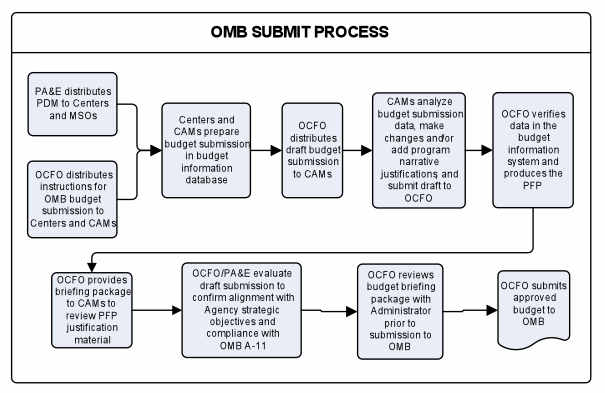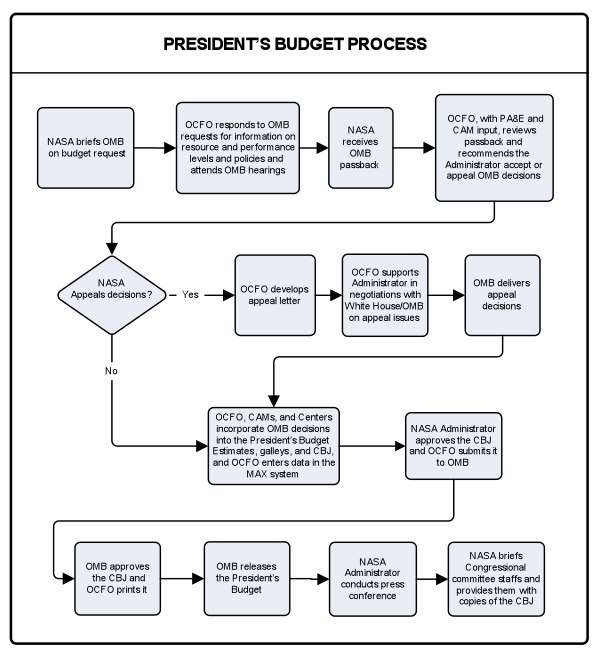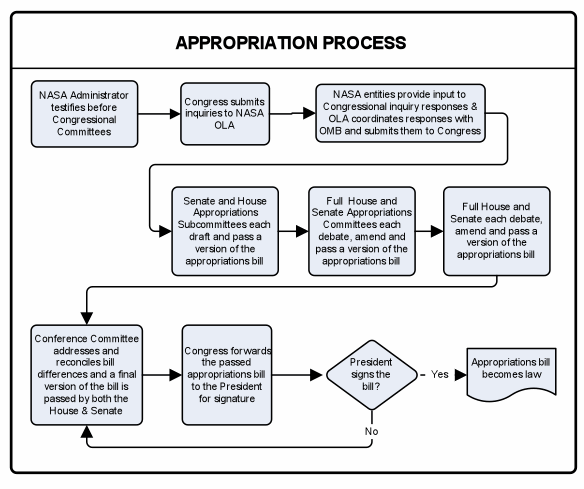Chapter 4. Budgeting
4.1 Overview
4.1.1 The Budgeting Phase includes formulation and justification of the budget to OMB and Congress. Resource allocations established during the Programming Phase are revised based on Program Decision Memorandums, the Congressional Budget Justification (CBJ) is prepared, the budget is defended, and the Congress appropriates funding for NASA to achieve its vision and mission.
4.2 Programmatic and Institutional Guidance (PaIG)
4.2.1 Purpose. In this step, CAMs allocate resources and provide guidance to reflect the decisions made in the PDMs. These allocations are at the project level detail necessary for Centers to adjust the NASA budget according to the PaIG.
4.2.2 Process. PA&E provides to OCFO and the CAMs a PDM trace sheet (budget table) to show changes to the SPG budget controls. OCFO then sets the budget controls in the budget formulation database. The CAMs review the PDM trace sheet and new budget controls and determine necessary allocations to the resource control totals to reflect direct project by Center funding and direct FTE by project by Center. OCFO then ensures that the CAM allocations are in accordance with the PDMs and distributes the new resource control figures to the Centers to begin the next step. No additional funding is created in this step, but there may be additional narrative guidance to assist CAMs in planning and making adjustments based on the PDM decisions. An illustration of the PaIG process is provided in Figure 4-1.

Figure 4-1, PaIG Process
4.2.3 Timeline. This step begins after the release of the PDMs to allow Centers and CAMs time to begin development of the budget details.
4.2.4 PaIG Responsibilities.
4.2.4.1 CAMs. Allocate programmatic and institutional PDM decisions to resource control figures by direct project by Center and direct FTE by project by Center. Make adjustments before and after the Centers to reconcile data.
4.2.4.2 OCFO. Set control totals in the budget formulation database according to the PDM trace sheet provided by PA&E. Ensure that CAM allocations comply or reconcile with resource control totals in the PDMs. Distribute the new resource control figures to the Centers.
4.2.4.3 Centers. Make adjustments to budget database and reconcile FTE data.
4.2.4.4 PA&E. Develop a PDM trace sheet to show changes to the SPG budget controls and provide to OCFO.
4.3 The OMB Submit
4.3.1 Purpose. In this step, the CAMs develop the OMB budget submission (OMB Submit) in accordance with instructions from OCFO. This is the first step in the budget formulation process in which the product is distributed outside of NASA. However, it is still pre-decisional data and is provided to OMB only. It is also the step in which the planning/programming information is converted into the full array of budget justification data. OCFO and PA&E evaluate the submission to confirm alignment with the Agency strategic objectives, to ensure that the proposed budget is compliant with the PDMs and OMB Circular No. A-11, and to ensure that it is well-justified, executable, and defensible. In addition, as part of the submit PA&E submits the budget year draft Performance Plan. After settlement, the Performance Plan is adjusted as needed and resubmitted for OMB concurrence.
4.3.2 Process. OCFO evaluates the budget submission data and CAM adjustments to ensure compliance with the PaIG. OCFO then develops the PFP. OCFO develops the Agency briefing package with the support of the CAMs and PA&E and reviews the charts with the Administrator before submitting the budget to OMB. The OMB Submit process is depicted in Figure 4-2.

Figure 4-2, OMB Submit Process
4.3.3 Timeline. This step begins in August after completion of the PaIG and is due to OMB the first Monday after Labor Day in September to meet the traditional OMB deadline.
4.3.4 OMB Submit Responsibilities.
4.3.4.1 CAMs. Review Agency briefing and develop detail CAM briefing material for OMB in accordance with instructions.
4.3.4.2 OCFO. Prepare and distribute instructions for development of OMB Submit to CAMs. Review budget input and ensure that budget submissions comply with PDM control totals. Develop the PFP and narrative material for briefing to OMB, working with CAMs on what is required for narrative justifications. Together with PA&E, confirm alignment with the Agency strategic objectives and the PDMs and to ensure that the proposed budget is compliant with OMB Circular No. A-11, well justified, executable, and defensible. Review the budget briefing package with the Administrator, submit to OMB, and serve as the primary point of contact with OMB.
4.3.4.3 PA&E. Review briefing products from the OCFO and CAMs to validate consistency with decisions in support of the OMB budget and justification submission, and to ensure that the proposed budget is compliant well justified, executable, and defensible.
4.4 The President’s Budget
4.4.1 Purpose. In this step, OCFO responds to OMB questions on the budget submission, coordinates hearings with Mission Directorates, receives and responds to passback, and works appeals and settlement. The CBJ is developed and assembled for dissemination. This represents NASA’s share of the total Federal budget request and includes the detailed schedules required by the Congressional Appropriations Committees.
4.4.2 Process. NASA provides briefings to OMB staff and any additional supporting justification requested during OMB’s analysis of NASA’s initial budget submission. OCFO, with PA&E and CAM support, responds to OMB questions concerning policies and resource and performance levels. OMB staff presents options for final decision in the OMB Director’s Review and develops the passback and guidance on the appeals process, which are typically released to agencies in late November. OCFO and PA&E review the passback, involving CAMs, as appropriate, and make recommendations to the Administrator on whether to accept or appeal OMB’s decisions. If the Administrator chooses to appeal, OCFO prepares the appeal letter and sends it to OMB and provides material in support of negotiations. An iterative process ensues until OMB submits to NASA a settlement. OCFO then issues instructions to CAMs and Centers to update the budget data to reflect the new resource levels. This includes input to the President’s Budget documents and galleys and input into MAX and the NASA budget information system, which is linked to the CBJ. OCFO informs the OMC and SMC of the final decisions that will be identified in the CBJ. When development of the CBJ is complete and approved internally at NASA, OCFO submits it to OMB for final review and approval, before publication. On the first Monday in February, OMB formally releases the President’s Budget, and the NASA Administrator conducts a press conference to discuss the NASA budget request. Subsequently, working with the Strategic Communications Office/Office of Legislative and Intergovernmental Affairs (OLIA), NASA staff briefs Congressional committee staffs and OLIA delivers copies of the CBJ to them. An illustration of the President’s Budget process is provided in Figure 4-3.

Figure 4-3, President’s Budget Process
4.4.3 Timeline. This step formally begins in September immediately following the OMB Submit and ends with Administrator and other senior leadership briefings to Congress on NASA’s portion of the President’s Budget after formal release of the President’s Budget to Congress on the first Monday in February.
4.4.4 President’s Budget Responsibilities.
4.4.4.1 CAMs. Provide input as required by OCFO to the President’s Budget documents. When notified that settlement has been reached, update resource and performance levels in the budget database and develop narrative changes to correspond to changes negotiated between NASA and OMB.
4.4.4.2 Centers. When notified that settlement has been reached, update resource and performance levels in the budget database if needed and develop fact sheets based on instructions from OCFO.
4.4.4.3 OCFO. Serve as the primary point of contact with OMB. Coordinate NASA budget hearings with OMB and ensure all OMB questions and issues are addressed. Prepare appeal letters on issues, coordinated through the affected offices and PA&E and approved by the Administrator. Take the lead role in preparing appeal responses to OMB and in preparing material in support of negotiations (meetings leading to settlement), coordinating with CAMs and PA&E. Track all OMB questions and ensure all issues are addressed. Maintain resource control totals for the President’s Budget submission and document final settlement budget trace in a PDM and provide to PA&E for processing. Coordinate and facilitate development of the CBJ. Provide budget formats and instructions to CAMs and Centers for the preparation of input to the CBJ. Provide formats and instructions to CAMs for the preparation of input to the Congressional budget briefings and the OMB MAX budget information system. Ensure budget tables in the CBJ correspond to levels agreed to by NASA and OMB and that the resources requested correspond to the narrative justifications through the clearinghouse process. Ensure MAX input and galley developments are complete and consistent with other data. Prepare and brief budget rollout materials. Coordinate development and submission of the institutional budget inputs (CM&O, AM&O, and Institutional Investments). Ensure submissions are in compliance with Agency policy and senior leadership decisions. Prepare and brief budget rollout materials. Submit the briefing package to the Administrator for approval. Finalize CBJ editing and obtain concurrence from CAMs, PA&E, and OMB, approving ready for print. Provide copies within NASA, to OMB, and OLIA for Congressional dissemination.
4.4.4.4 PA&E. Reviews passback and validates NASA responses to questions and appeals. Validate Project cost and schedule data in CBJ to ensure it is consistent with the Major Program Annual Report and other cost and schedule reporting. Verify and validate Mission Directorate submission of threshold report and its relationship to the requested budget. Confirm that the CBJ input corresponds to NASA and Administration policies and strategic decisions through eBudget. Review rollout materials to ensure they accurately capture and present intended programmatic decisions. Review and concur with final draft of CBJ prior to it being printed. Support Strategic Communications in development of the Administrator’s budget statement and press conference information.
4.4.4.5 Strategic Communications/OLIA. Coordinate meetings to prepare for the budget roll out. Serve as the primary point of contact with Congressional committees. Disseminate CBJ and other budget documents to Congressional committees and staffs. Coordinate Agency presentations and defense of budget before Congress, including development of testimony and hearing records and correspondence with Congress, and response to questions. Strategic Communications/Public Affairs: Sets up Administrators press conference and any media required to roll out the President’s budget. Post CBJ and briefings to the nasa.gov web site.
4.5 Appropriation
4.5.1 Purpose. In this step, NASA presents and defends the President’s Budget and monitors Congressional progress in developing the NASA appropriation bill in response to the President’s Budget. During this step, NASA also attempts to understand the guidance that Congress includes in committee reports and statutes related to Congressional intent with regard to funding provided by Congress and prepares for changes to the President’s Budget when those seem likely.
4.5.2 Process. After OMB releases the President’s Budget, the NASA Administrator testifies on the submitted budget before Congressional Committees, typically the Authorization Committees first and then the Appropriations Subcommittees. After this testimony, the Committees/ Subcommittees forward questions to NASA, which require a formal response. NASA staff prepares the responses, coordinates them with OMB, and returns them to the Committees/ Subcommittees. After NASA responses are submitted, the House Appropriations Subcommittee prepares a markup of the appropriation bill and passes it. Subsequently, the full House Appropriations Committee and then the full House take up the bill and pass a version. The Senate Appropriations Subcommittee, the Senate Appropriations Committee, and the full Senate go through a similar process. After the House and Senate have both passed their versions of the appropriations bill, a Conference Committee convenes to resolve differences and craft a conference bill that is subsequently passed by both the House and Senate and sent to the President. Throughout these proceedings, NASA staff monitors the status of NASA’s appropriations. When the House or Senate Committees, Subcommittees, or Conference Committee identify resource levels or policy guidance different from that proposed by the President, NASA staff develops options for implementing the differences. NASA may also provide input to OMB for a Statement of Administration Policy when OMB differs sharply with the position taken by the Congress. Once the House and Senate have reached agreement and passed the appropriations bill, it is sent to the President to sign into law. If Congress is unable to pass the regular appropriations bill by October 1, they typically pass a continuing resolution that allows the Government to remain operational for a specific length of time. More than one continuing resolution may be passed. NASA staff monitors the wording of the continuing resolution and recommends wording to OMB if there are needs that must be met early in the fiscal year that are beyond the limits of this bill. NASA staff also makes preparations to continue operations under the continuing resolution or for shutdown of operations if a bill is not passed and a lapse in appropriations occurs. An illustration of the Appropriation process is provided in Figure 4-4.

Figure 4-4, Appropriation Process
4.5.3 Timeline. When Congress passes and the President signs the appropriation bills, theoretically before the execution year starts on October 1, but likely late fall or winter.
4.5.4 Appropriation Responsibilities.
4.5.4.1 CAMs/Centers. Provide input to testimony and other support as required.
4.5.4.2 OCFO. Provide input to testimony and other support as required. Monitor Congressional action and initiate the development of alternatives based on probable Congressional action on resource levels or guidance.
4.5.4.3 OLIA. Coordinate testimony by the Administrator and others that may be requested by the Authorization or Appropriations Committees. Coordinate preparation of responses to Committee questions. Assist Committee staff in preparing for mark up of the budget request and in addressing amendments during floor consideration of bill. Provide information to Committee staff as to Agency budget priorities during Appropriations Conference activity.
4.5.4.4 PA&E. Provide input to testimony and other support as required. Provide programmatic analysis of impacts of budget questions and possible changes.
DISTRIBUTION:
NODIS
This Document is Obsolete and Is No Longer Used.
Check the NODIS Library to access the current version:
http://nodis3.gsfc.nasa.gov
![[NASA Logo]](../Images/nasaball.gif)



